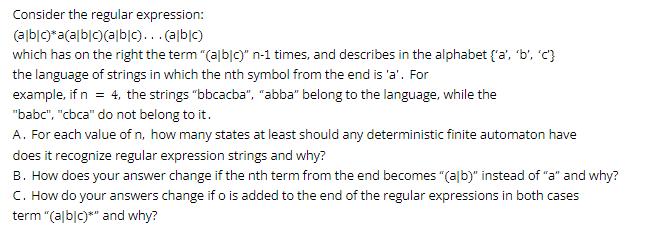Answered step by step
Verified Expert Solution
Question
1 Approved Answer
Consider the regular expression: (albic)*a(albic) (albic)...(albic) which has on the right the term (alb|c) n-1 times, and describes in the alphabet {'a', 'b', 'c'}

Consider the regular expression: (albic)*a(albic) (albic)...(albic) which has on the right the term "(alb|c)" n-1 times, and describes in the alphabet {'a', 'b', 'c'} the language of strings in which the nth symbol from the end is 'a'. For example, if n = 4, the strings "bbcacba", "abba" belong to the language, while the "babc", "cbca" do not belong to it. A. For each value of n, how many states at least should any deterministic finite automaton have does it recognize regular expression strings and why? B. How does your answer change if the nth term from the end becomes "(alb)" instead of "a" and why? C. How do your answers change if o is added to the end of the regular expressions in both cases term "(alb|c)*" and why?
Step by Step Solution
★★★★★
3.37 Rating (156 Votes )
There are 3 Steps involved in it
Step: 1
A For each value of n a deterministic finite automaton DFA should have at least n1 states to recogni...
Get Instant Access to Expert-Tailored Solutions
See step-by-step solutions with expert insights and AI powered tools for academic success
Step: 2

Step: 3

Ace Your Homework with AI
Get the answers you need in no time with our AI-driven, step-by-step assistance
Get Started


